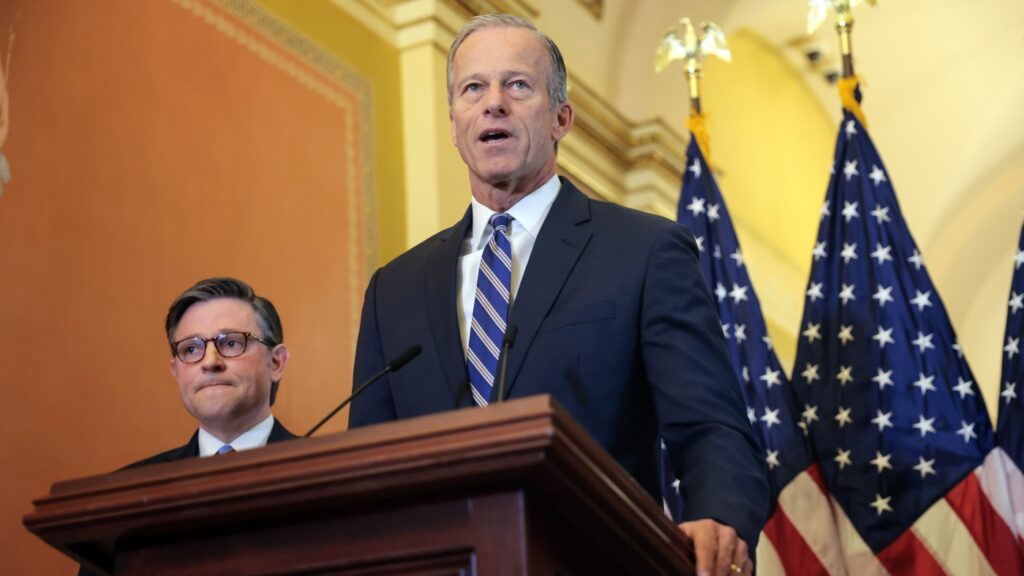
WASHINGTON, DC - APRIL 10: U.S. Senate Majority Leader John Thune (R-SD) (R) and Speaker of the House Mike Johnson (R-LA) hold a press conference on the Republican budget bill at the U.S. Capitol on April 10, 2025 in Washington, DC. The Republican leaders spoke on the reconciliation process and said they would find $1.5 trillion in cuts as the House prepares to vote on President Trump's budget outline for his tax and spending plan after Republican holdouts refused to vote without deeper cuts. (Photo by Kayla Bartkowski/Getty Images)
Senate Republicans have unveiled an updated version of their expansive spending and tax cut legislation, a cornerstone of President Trump’s domestic agenda. This development sets the stage for a Senate vote just days before the GOP’s self-imposed July 4 deadline. The proposed bill mirrors many elements of the House version passed in May, including extensions of Trump’s 2017 tax cuts and increased allocations for border security, defense, and energy production.
Republican leaders aim to initiate votes on the bill by Saturday. The legislative process will involve an open-ended amendment series that could extend into Sunday, potentially leading to further modifications. However, divisions remain within the party regarding funding these initiatives. Notably, the Senate’s proposal includes a larger debt limit increase and significant changes to Medicaid, diverging from the House’s plan.
Key Differences in the Senate Bill
The Senate’s version of the bill incorporates adjustments recommended by Senate Parliamentarian Elizabeth MacDonough, who plays a crucial role in ensuring compliance with chamber rules. Her review led to the removal of several provisions that did not qualify for a simple majority vote under reconciliation.
The bill is expected to encounter resistance from various Republican factions, particularly fiscal conservatives concerned about the deficit and lawmakers opposed to substantial cuts in social safety net programs. Internal debates also persist over the nation’s borrowing limit, with Senator Rand Paul of Kentucky pledging to oppose the bill on this issue.
Tax Incentives and Adjustments
The Senate bill includes several tax-related campaign promises from President Trump. It proposes temporary changes allowing Americans to deduct up to $25,000 for tip wages and $12,500 for overtime pay through 2028. However, these deductions will be reduced for individuals earning over $150,000, a provision absent in the House version.
Additionally, the Senate bill raises the child tax credit from $2,000 to $2,200 per child, with inflation adjustments after 2025. This contrasts with the House’s temporary increase to $2,500 before reverting to current levels. The Senate also proposes a permanent expansion of the standard deduction, differing from the House’s temporary measure through 2028. A tax deduction for individuals over 65 is increased to $6,000, compared to $4,000 in the House bill, with a phase-out for those earning above $75,000.
Debt Ceiling and Economic Implications
The Senate proposes a $5 trillion increase in the national debt limit, surpassing the House’s $4 trillion proposal. Raising the debt ceiling does not authorize new spending but allows the government to meet existing obligations. Failure to lift the cap could lead to a default, with catastrophic consequences for both the U.S. and global financial systems. The Congressional Budget Office warns that without Congressional action, the U.S. may exhaust its funds between mid-August and late September.
“Earlier this month, 38 members signed a letter to Senate Majority Leader John Thune, criticizing the size of the proposed debt limit increase.”
Social Programs and Controversies
Both the Senate and House bills propose reforms to the Supplemental Nutrition Assistance Program (SNAP), which aids over 40 million low-income Americans. The Senate version expands work requirements for “able-bodied adults” up to age 64, with exemptions for parents of children under 14. It also limits state waivers for these requirements and shifts more costs to states based on erroneous payment rates, effective in 2028.
Continuity and Changes in Key Areas
The Senate bill maintains $4 trillion in tax cuts, slightly exceeding the House’s $3.8 trillion proposal. This move extends Trump’s 2017 tax cuts, set to expire this year, preventing potential tax increases for most households.
Both bills allocate $46.5 billion for completing Trump’s border wall, with additional funds for Customs and Border Protection facilities and broader border security. The Senate proposes less funding for hiring and retaining agents than the House, but both invest in advanced border surveillance technology.
The Senate version also introduces new or increased immigration service fees, including a $550 charge for work authorization applications. However, a proposed $1,000 asylum application fee was removed following the parliamentarian’s review.
Education and Technology Provisions
In education, the Senate bill mirrors the House’s plan to overhaul student loan repayment options, replacing them with a standard and an income-based “Repayment Assistance Plan.” It caps federal loan amounts for parents and graduate students annually. Unlike the House, the Senate retains current Pell Grant eligibility rules but bars students with full scholarships from receiving them.
The Senate proposal allocates $500 million to the Broadband, Equity, Access, and Deployment Program, supporting broadband access and AI model development. However, states must refrain from regulating AI for a decade to receive this funding, a stipulation also in the House bill.
This evolving legislative landscape highlights the complexities of balancing fiscal responsibility with policy priorities. As the Senate prepares for a vote, the outcome will significantly impact both domestic policy and the political dynamics within the GOP.





